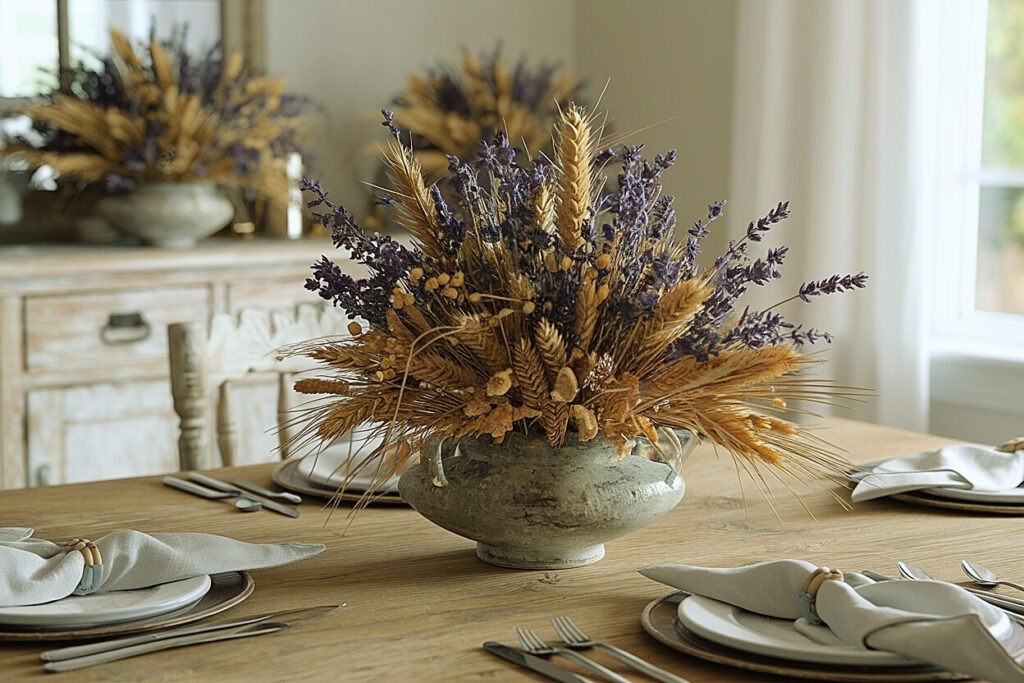
This website contains affiliate links, and some products are gifted by the brand to test. As an Amazon Associate, I earn from qualified purchases. Some of the content on this website was researched and created with the assistance of AI technology.
Key Takeaways
- Pair lavender with matte, textural botanicals (wheat, hydrangea, statice, thistle) to balance its fine line and cool tone.
- Standardize mechanics: wire 3–5 stem lavender bundles at 4–5 inches, hide ties with floral tape, and keep arrangements low for conversation.
- Repeat one metal and one ribbon across rooms; echo the same lavender mix in garlands, centerpieces, sideboards, and windowsills for cohesion.
The Best Dried Flowers to Mix with Lavender for Thanksgiving Décor starts with a simple truth: lavender behaves like punctuation—clean, cool, and precise. It needs neighbors with body, matte texture, and soft edges to make the sentence sing. When I build a Thanksgiving story, I let lavender provide the herbal breath and line while sturdier dried forms supply volume and warmth.
I’ve learned to think in profiles, not just colors. Lavender’s dusty violet loves wheat’s straw gold, statice’s papery clusters, hydrangea’s big domes, and thistle’s spiky orbs. With the right mechanics—short wired bundles, concealed ties, and measured spacing—you get design that looks intentional, smells calm, and survives the whole holiday weekend.
Quick scan: Five essentials keep your lavender mixes cohesive across windows, mantels, sideboards, hutches, and benches. Table on larger screens, accordion on phones.
| Core Topic | What to Focus On | Windows & Furniture Cues | Quick Wins |
|---|---|---|---|
Foundations & Flower Choices StructureBalance |
|
|
|
Texture & Volume DepthFlow |
|
|
|
Color & Palette HarmonyAccent |
|
|
|
Vessels & Placement ContainElevate |
|
|
|
Scent, Care & Guest Experience ComfortPractical |
|
|
|
Foundations & Flower Choices
- Complement lavender with wheat, roses, hydrangea
- Add contrast: thistle, statice, marigold
- Soften with baby’s breath, cotton, pampas
- Trim stems to windowsill depth (≤4″)
- Heavier blooms on sideboards/hutches
- Tall grasses beside windows
- Odd-number clusters (3–5–7)
- Mix dried + preserved
- Palette test on a napkin
Texture & Volume
- Hydrangea, pampas, grasses for volume
- Thistle, seed pods, pinecones for contrast
- Baby’s breath, statice for lift
- Use trays on consoles to catch shed
- Foam collars inside vases
- Mirror textures on hutches
- Build center → edges
- Vary stem angles
- Leave negative space
Color & Palette
- Lavender, cream, sage, walnut
- Marigold, dried oranges, copper
- Olive leaves, eucalyptus
- Pull metallics toward windows
- Echo accent ribbon on chairs
- Keep bold tones on sideboards
- Two metal finishes max
- Repeat one hue per zone
- Golden-hour photos
Vessels & Placement
- Glass/ceramic/amber vases
- Wood trays, crates, cloches
- Floor vases by windows
- Low centerpieces for sightlines
- Tier heights on hutches/mantels
- Clear edges for drawers
- Triangle groupings
- Hide mechanics with moss/leaves
- Duplicate a mini on the bench
Scent, Care & Guest Experience
- Herbal blends: rosemary, sage, thyme
- Balance fragrance near dining
- Low-shed picks for textiles
- Seat scent-sensitive guests away
- Favors staged on sideboards
- Baskets on benches for spares
- Light setting spray mist
- Tiny variety labels
- Send clipped keepsakes
How to Combine Lavender with Dried Wheat for Rustic Thanksgiving Charm
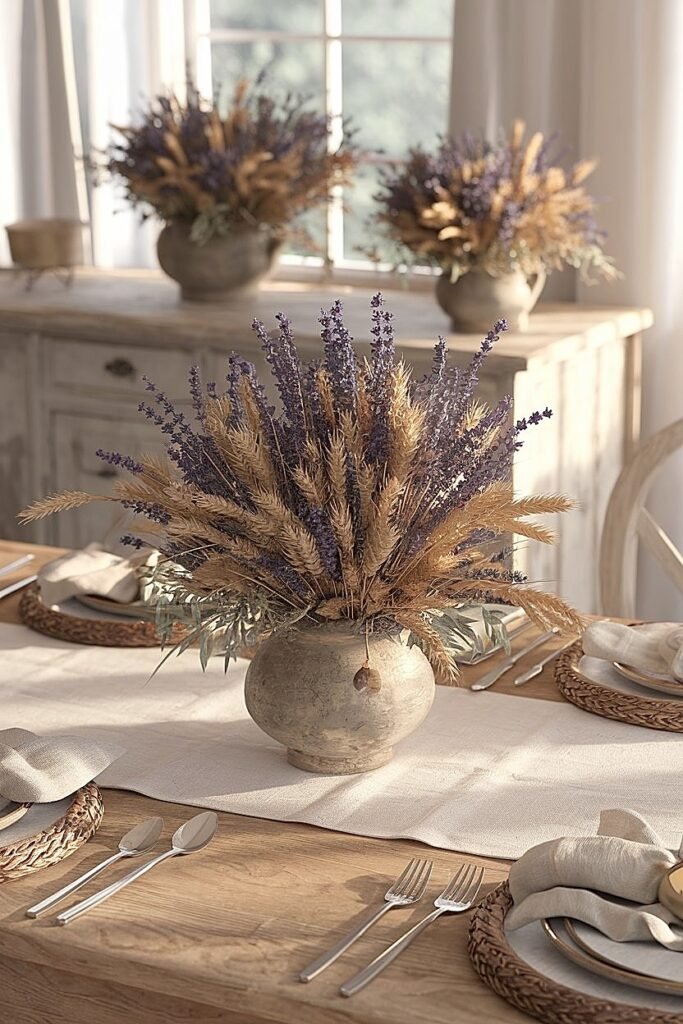
Wheat brings backbone and glow. I treat it as the scaffolding that holds lavender’s delicate movement. Start with 10–12 inch wheat sheaves and remove any brittle chaff near the binding point. Split each sheaf into thirds so the texture feels layered, not bulky. Then wire 3–5 stem lavender bundles at 4–5 inches and tuck them at 45 degrees into the wheat’s natural lines.
Keep sightlines low. I fan wheat horizontally along a slender runner, allowing lavender to arc like cursive between the straw. The contrast—straw matte against lavender’s cool bloom—reads rustic and refined at once. If the room runs warm (lots of brass and terracotta), add a whisper of dusty miller to cool the palette without stealing the harvest story.
Use wheat as a low fan, stitch short lavender bundles on angles, and cool with a touch of silver foliage if metals run hot. For garland-specific mechanics that align with this mix, see Ways to Use Lavender in Thanksgiving Garland Arrangements—and if this sparks ideas, share the post with friends who love a calm, fragrant holiday look. More flower pairing nuance ahead—keep reading.
What Are the Best Dried Roses to Pair with Lavender for Thanksgiving?
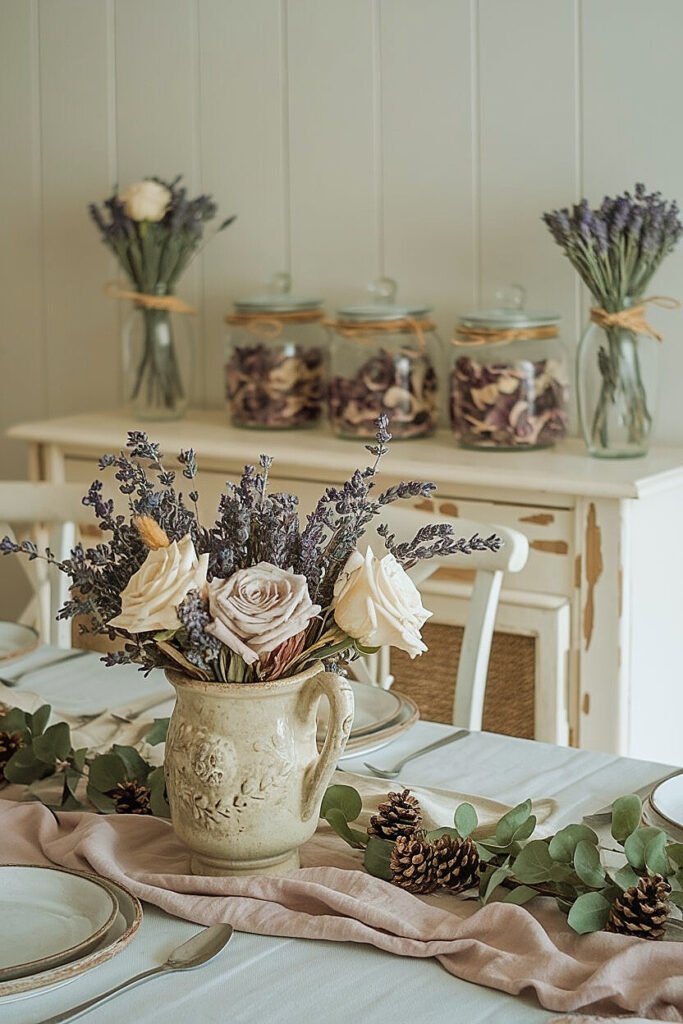
- Garden Rose (Antique Blush):
Large, cupped heads dry into soft, ruffled discs that add romance without glare. Their blush-to-ivory gradient bridges lavender’s coolness to neutral linens and bone tapers. I wire each head through the calyx with 22–24 gauge wire, tape slim, and seat them slightly deeper in the arrangement so lavender’s line skims across the petals. Perfect for sideboards and low centerpieces where you want a vintage hush. - Spray Rose (Dusty Pink or Mauve):
Smaller heads deliver repetition and rhythm without overwhelming space. Mauve tones make lavender feel deliberate, not accidental. I cluster three mini heads with one lavender bundle to form a “unit,” then repeat those units every 10–12 inches in garlands or along a runner. This modular approach keeps the composition tidy and easy to edit before guests arrive. - Dried White Rose (Ivory/Vanilla):
When the palette needs air, ivory roses calm everything. Their matte, parchment finish loves pewter and stoneware. I offset each white head with a single sprig of rosemary or olive for green continuity, then lay lavender slightly forward so scent moves first. Use sparingly—white holds attention fast; let lavender carry the melody.
Use blush garden roses for romance, mauve spray roses for rhythm, and ivory roses for lift; wire through calyces and seat roses deeper so lavender can lead. More lightness next—keep reading to float baby’s breath without going bridal.
How to Mix Dried Baby’s Breath with Lavender for Lightness
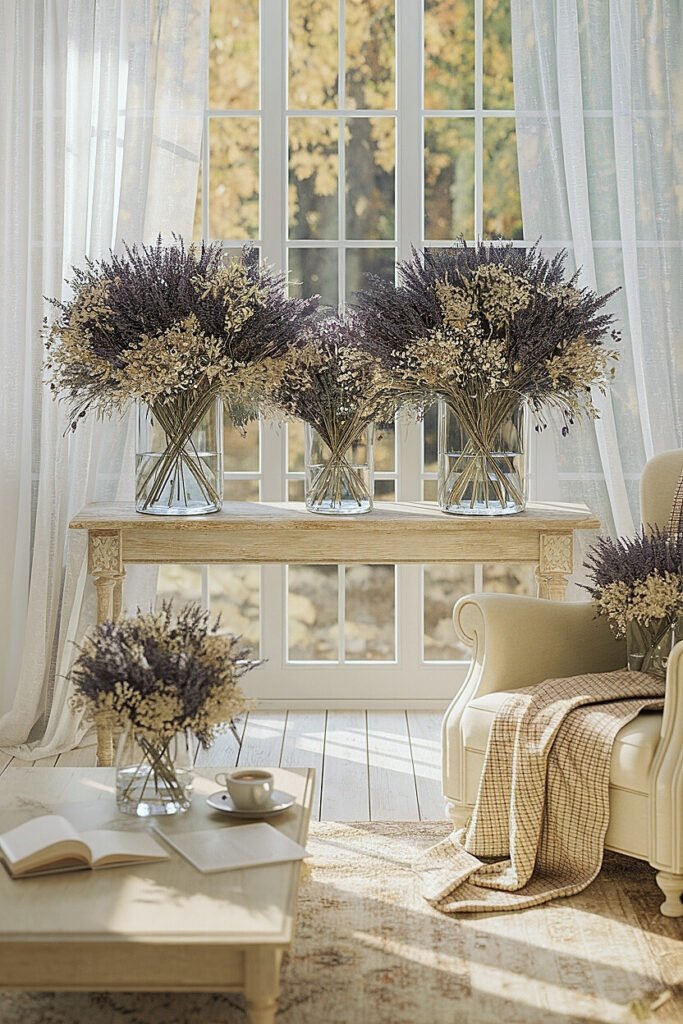
Baby’s breath (Gypsophila) adds foam and air, but scale and density matter. I snip into 2–3 inch cloudlets and treat them as negative-space fillers between lavender accents, not as blankets. Sprinkle them where the eye needs rest—between wheat fans, around mini pumpkins, or flanking a hydrangea dome.
Color-tune the breath. Natural ivory brightens; bleached white can glare under LEDs. I prefer natural or slightly tea-stained tones to sit comfortably beside lavender’s dusty hue. Mechanically, I glue-tip the tiny stems or tape them to short picks so they won’t shed across linens when plates move.
Use 2–3 inch cloudlets as airy pauses, keep tones warm-ivory, and mount on picks to prevent shed. More volume next—keep reading to work hydrangeas without swallowing the table.
Ways to Use Dried Hydrangeas with Lavender for Thanksgiving
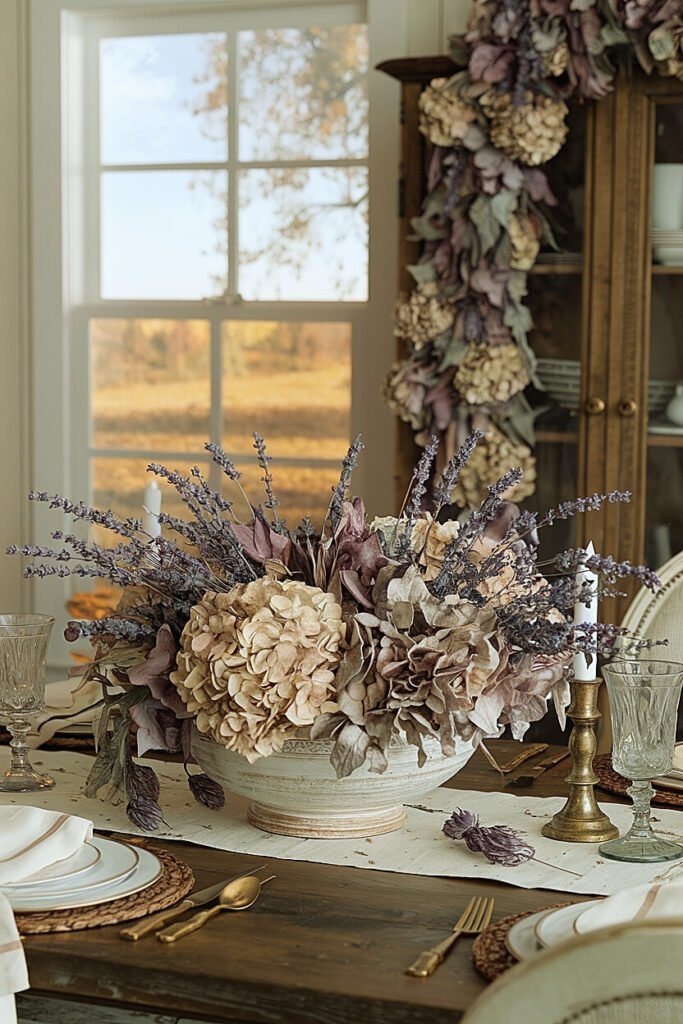
- Low Dome Centerpiece:
Seat one or two dried hydrangea heads (oakleaf or mophead) on a shallow bed of olive, then stitch lavender in arcs across the dome. Hydrangea supplies mass; lavender draws line and scent. Keep total height under eight inches to protect conversation. - Mantel Bookends:
Two asymmetrical hydrangea clusters at mantel ends, tied together by a slim lavandin sweep. Hydrangea anchors the composition; lavender carries movement to the center. Add mercury cups in front to wash soft light over the blooms. - Tray Vignette:
A rustic wooden tray with a single hydrangea head, a mini pumpkin, and a lavender collar ring. It’s a portable vignette: lift the tray to clear space for service, then settle it back afterward—no redesign required. - Wreath Insert:
Use hydrangea as shallow wedges around a thin olive/lavender wreath. Place wedges at 10 and 2 o’clock; run lavender like a horizon line across the lower third. This composition feels modern and balanced. - Windowsill Trio:
Three mini hydrangea heads in narrow jars, connected by a slim lavender garland. The jars offer water for any fresh elements while the garland keeps the story continuous along the sill.
Let hydrangea supply quiet mass and lavender supply motion; keep profiles shallow and light forward-facing for glow. More texture play next—keep reading for pampas selections that won’t shed everywhere.
What Are the Best Dried Pampas Grasses to Mix with Lavender for Thanksgiving?
- Cortaderia selloana (Mini Plumes):
Short, compact plumes add height without chaos. I trim to 10–14 inches and keep count low (odd numbers) so lavender remains the lead. The soft taupe tone pairs well with pewter and bone linens. - Pennisetum setaceum (Fountain Grass):
Smaller, more controlled brushes. These are ideal for end clusters on runners where you want a feathery gesture but not a duster. Their fine texture echoes lavender’s delicacy. - Pennisetum glaucum (Purple Millet Plumes):
Moody, wine-toned plumes ground lavender’s coolness. I use one or two to add a vertical accent near a pumpkin group; they read editorial under low light. - Stipa tenuissima (Mexican Feather Grass):
Whispy motion for photographs and drafts near doorways. Keep stems short and few, and secure well to avoid tickle near plates. - Lagurus ovatus (Bunny Tails):
Tactile and playful. I cluster five to seven tails near napkin stations or favor trays; their scale suits close-up moments and they don’t steal height.
Choose compact, well-behaved plumes in restrained numbers; trim short and secure firmly so lavender stays the star. More wild harvest energy next—keep reading to add statice with intention.
How to Blend Dried Statice with Lavender for a Wild Thanksgiving Harvest Look
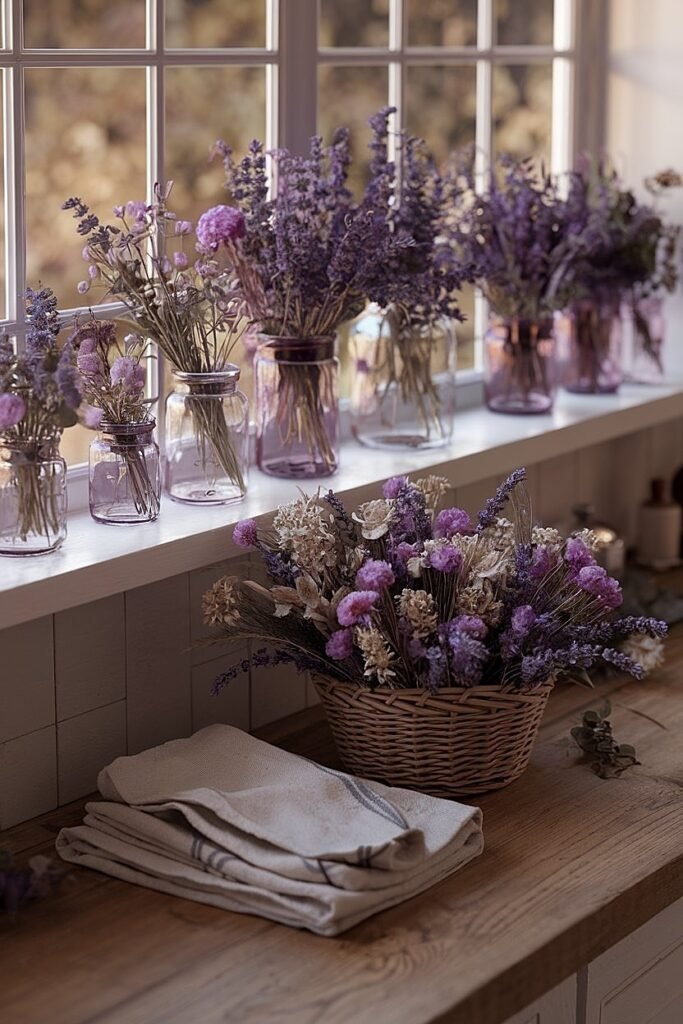
Statice (Limonium) carries papery clusters that read wild meadow when used loosely. I strip the bottom leaves and break stems into 4–6 inch segments, then weave them just below lavender arcs so color dots peek through without crowding. Purple-on-purple can feel heavy, so I favor cream, mauve, or dusty lilac statice to gradient the palette.
Statice also excels at hiding mechanics. Tuck small tufts over wire junctions and LED leads; the texture masks hardware while adding festival sparkle. Use sparingly in dining zones—its papery rustle can amplify in quiet rooms, so balance with soft linens.
Place 4–6 inch statice segments beneath lavender lines, pick lighter tones for gradient, and leverage its texture to conceal mechanics. More aroma layering next—keep reading for herbs that play nice with lavender.
What Are the Best Dried Herbs to Mix with Lavender for Scent and Color for Thanksgiving?
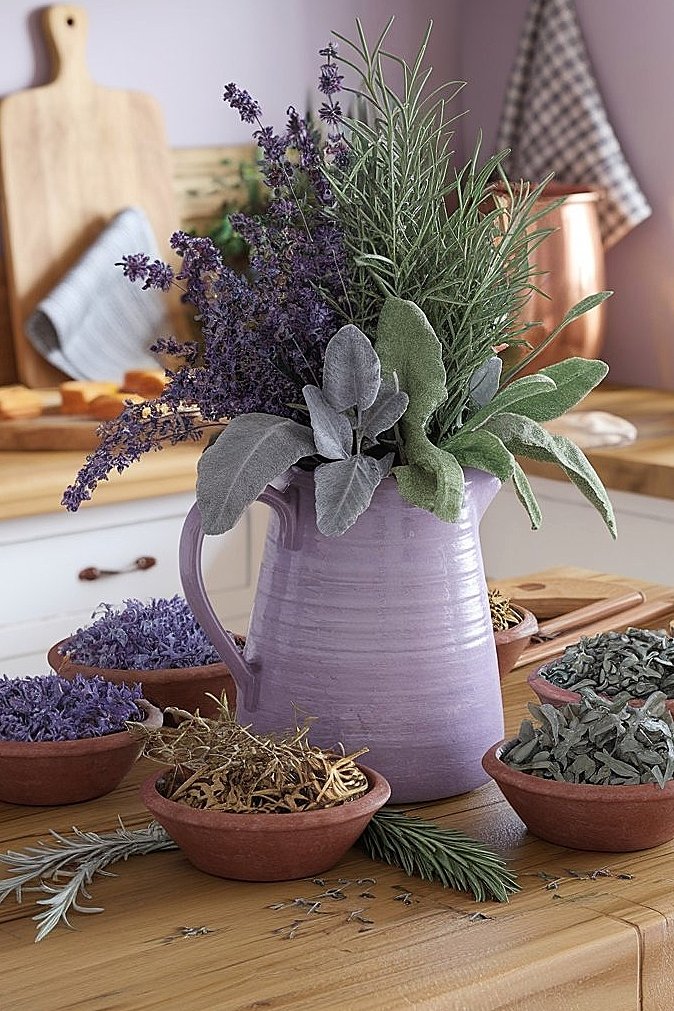
- Rosemary:
Upright needles add structure and a savory counterpoint to lavender’s floral note. I wire 3–4 inch sprigs into collars around pumpkins or tuck at napkins. The evergreen tone bridges olive foliage and pewter metals while keeping the room appetite-forward. - Thyme (Lemon or Common):
Tiny leaves and branching habit bring fine texture at close range. Lemon thyme adds a bright top note; I use it near place settings and favor stations. Wire to micro picks to prevent shedding. - Sage (Berggarten or Common):
Velvety, cool-toned leaves mirror lavender’s bloom. I use single leaves as visual commas along a runner, pinning them with museum wax and a tiny lavender tuft on top. - Bay Laurel:
Glossy, architectural leaves read classic and clean. I insert them as occasional “spines” within a garland to restore direction. Their herbal scent stays polite at dining distance. - Oregano (Dried Stems):
Feathery seed heads and a mild, familiar aroma. Oregano adds lightness to dense sections and pairs well with figs or grapes on pewter saucers.
Mix one structural herb (rosemary/bay) with one plush leaf (sage) and one fine-texture herb (thyme/oregano) alongside lavender to balance scent and shape. More earth next—keep reading to ground the palette with ferns.
How to Pair Dried Ferns with Lavender for Earthy Elegance
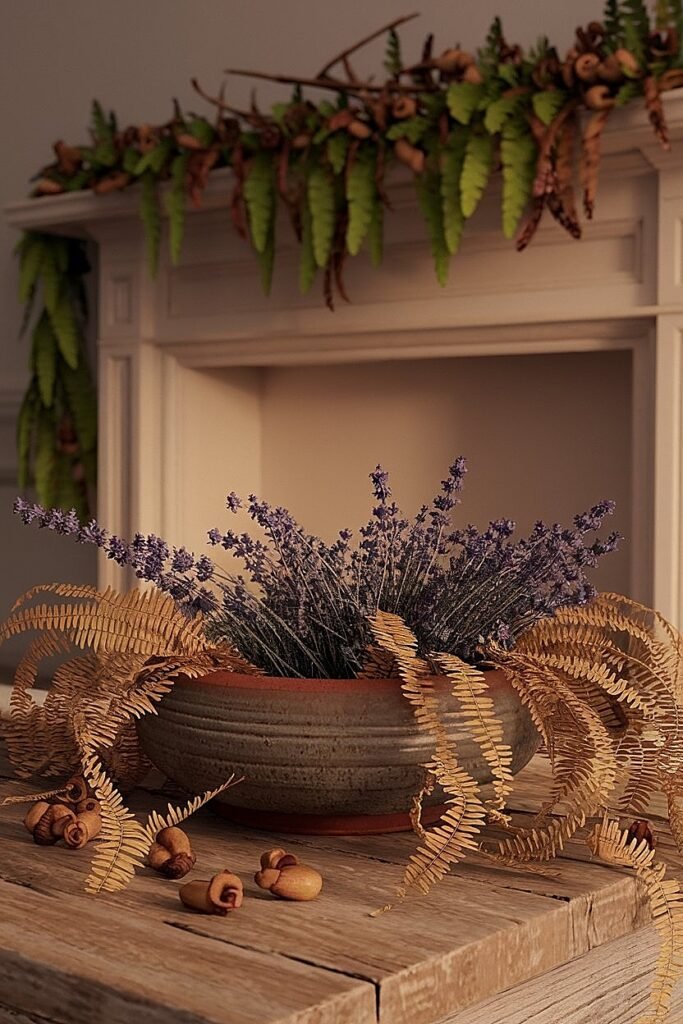
Ferns introduce woodland quiet. I like pressed or naturally dried leatherleaf and maidenhair. Leatherleaf offers silhouette; maidenhair brings soft, lacy detail. I layer flat fronds beneath lavender lines, letting the fern act like a shadow that deepens the scene without adding height.
Color-tune your ferns. Smoke-brown or olive tones keep the palette grounded; bright green reads spring. I mist fragile fronds lightly with a matte sealant to reduce flake, then slide them onto runners under trays or beneath hydrangea wedges. Lavender arcs across the top, stitching the whole story together.
Use flat, smoke-toned ferns as low “shadows” and arc lavender above for line and scent; seal delicate fronds to prevent flake. More edge and contrast next—keep reading to work thistle in without going prickly.
Ways to Combine Dried Thistle with Lavender for Texture Contrast
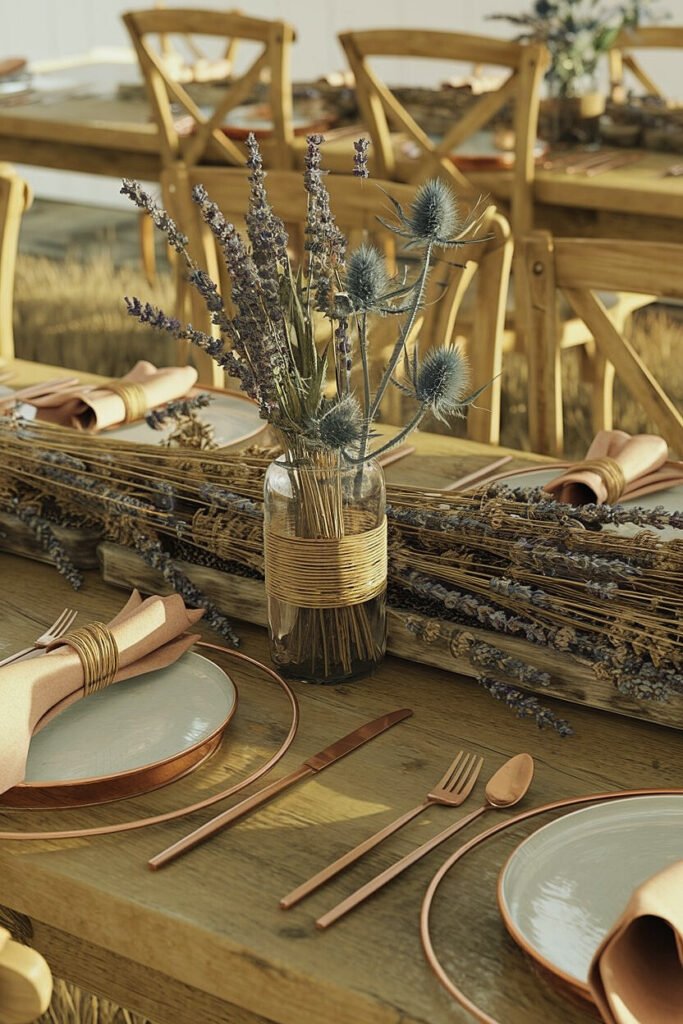
Thistle, especially Eryngium (sea holly) or globe thistle, delivers the most satisfying counterpoint to lavender’s softness. Their spiky geometry snaps a composition into focus. I trim stems to 4–6 inches and stage single heads near focal breaks—pumpkin edges, tray corners, or garland ends. Blue-gray tonality harmonizes with lavender; tan thistles add rustic heat.
Balance is everything. Too many thistles and the table feels armored. I cap usage at one thistle head for every three lavender bundles and seat them slightly deeper so spikes don’t snag sleeves. A pewter saucer beneath a thistle cluster adds weight and keeps the look intentional rather than improvised.
Deploy thistle as disciplined exclamation points—short stems, deeper seating, one-to-three ratio with lavender—for crisp contrast without clutter. There’s more throughout—keep reading to connect these mixes across garlands, mantels, and place settings.
Conclusion
Great Thanksgiving décor with lavender respects mechanics, palette, and profile. Choose dried companions that supply mass (hydrangea), structure (wheat, rosemary, bay), air (baby’s breath), movement (lavandin), and edge (thistle). Wire short bundles, hide ties, and keep height low so conversation and serving stay easy. Standardize one metal and ribbon, echo the same lavender mix in garlands and centerpieces, and corral accents on trays for quick resets. When every element has a job—scent, line, mass, or texture—the room feels composed, smells like calm, and invites people to linger long after the last slice of pie.
This website contains affiliate links, and some products are gifted by the brand to test. As an Amazon Associate, I earn from qualified purchases. Some of the content on this website was researched and created with the assistance of AI technology.
